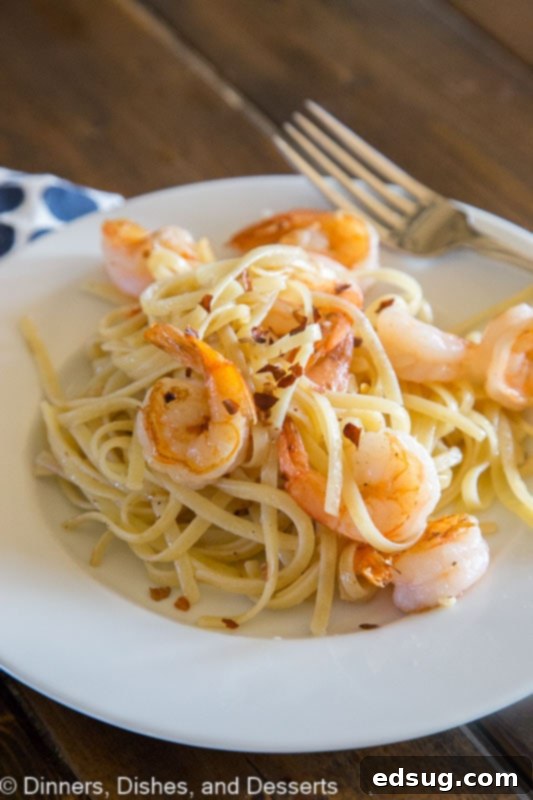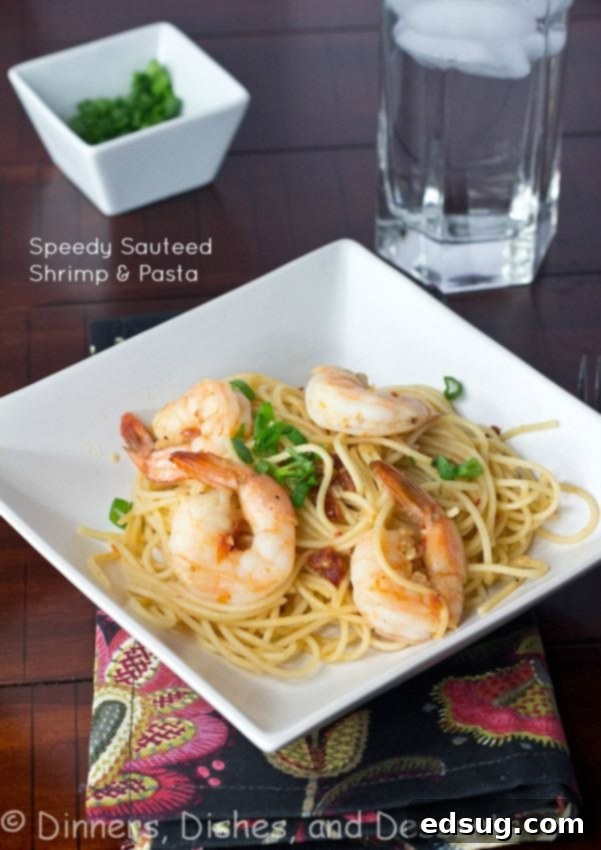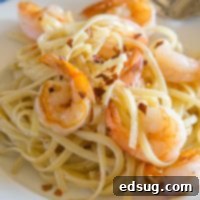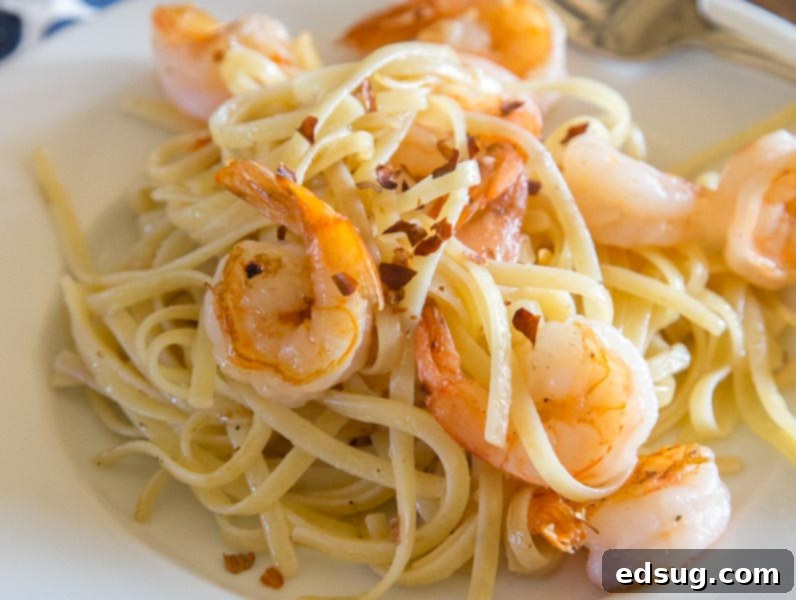Mastering the Art: How to Perfectly Sauté Shrimp for Exquisite Pasta Dishes
Sautéed shrimp is undeniably one of the fastest and most delicious protein options available, making it a perfect candidate for quick weeknight dinners and elegant weekend meals alike. When cooked correctly, shrimp offers a tender, juicy bite that effortlessly absorbs a multitude of flavors, transforming any pasta dish into a culinary delight. A comforting and flavorful shrimp pasta can be on your table in mere minutes, often in less time than it takes to boil the pasta itself.
Recipes like Speedy Sautéed Shrimp Pasta exemplify just how convenient and satisfying this ingredient can be. Imagine a delightful dinner prepared and served almost as quickly as you can get water to boil and pasta to cook – a true testament to the efficiency and ease of preparing shrimp. This article will guide you through all the essential tips and tricks to ensure your sautéed shrimp is always tender, flavorful, and never overcooked, making you a confident shrimp chef in no time.

Unlocking Shrimp Perfection: Essential Sautéing Tips & Tricks
Many home cooks shy away from cooking shrimp, intimidated by its delicate nature and the fear of ending up with rubbery, unappetizing results. However, with a few simple techniques, you can master the art of sautéing shrimp for pasta and achieve restaurant-quality texture and flavor every time. Let’s delve into the crucial steps that will elevate your shrimp cooking game.
- Proper Preparation: Pat the Shrimp Dry for Optimal Searing.
The journey to perfectly sautéed shrimp begins even before it hits the pan. It’s crucial to start with thawed shrimp that has been peeled and deveined. Whether you’re using fresh or frozen-then-thawed shrimp, the first and most critical step is to thoroughly pat it dry. Arrange the shrimp in a single layer on a plate or baking sheet lined with paper towels, then use additional paper towels to gently but firmly blot away all excess moisture. This step is non-negotiable because moisture on the surface of the shrimp will prevent it from searing properly. Instead of developing a beautiful golden-brown crust, wet shrimp will steam in the pan, resulting in a less desirable, softer texture. A dry surface allows for direct contact with the hot pan, promoting that delicious caramelization and quick cooking. - The Right Fat: Elevating Flavor and Achieving Ideal Texture.
Shrimp, while inherently sweet, can be quite subtle in flavor on its own. To truly bring out its best and achieve that rich, savory depth, you need to use a high-quality cooking fat. Butter is a classic choice for sautéing shrimp, lending a luscious, nutty flavor that complements seafood beautifully. Olive oil is another excellent option, especially extra virgin olive oil for its rich taste, or a neutral oil like avocado or grapeseed for higher smoke points if you prefer to cook at slightly hotter temperatures. You can even combine butter and oil for the best of both worlds – the flavor of butter with the slightly higher smoke point of oil. The fat not only adds flavor but also facilitates browning, ensures even cooking, and prevents the shrimp from sticking to the pan, creating a silky sauce base for your pasta. - Strategic Seasoning: Tailoring Flavors to Your Pasta Dish.
The beauty of sautéed shrimp lies in its incredible versatility. It acts as a blank canvas, ready to absorb any flavor profile you desire. While a simple sprinkle of salt and freshly cracked black pepper is always a good starting point, don’t be afraid to get creative! Consider the type of pasta dish you’re preparing. For a vibrant, zesty pasta, try fresh cilantro and a squeeze of lime juice. If you’re leaning towards a spicy, robust flavor, a generous dash of Cajun seasoning or a pinch of chili powder can work wonders. Minced garlic is almost always a welcome addition, pairing perfectly with shrimp in nearly any cuisine. Italian herbs like oregano, basil, and parsley, or a touch of red pepper flakes, can transform your shrimp into an instant Italian classic. The key is to season the shrimp directly before cooking, allowing the flavors to meld into the hot fat. - The Golden Rule: Do Not Overcook!.
This is perhaps the single most important piece of advice when cooking shrimp. Shrimp cooks incredibly fast, transitioning from perfectly done to tough and rubbery in a matter of seconds. Keep a very close eye on it throughout the cooking process. You’re looking for specific visual cues: as soon as the shrimp turns pinkish-orange on the outside and becomes opaque white in the center, it’s done. This usually takes only 1-2 minutes per side for medium to large shrimp. If it curls into a tight “O” shape, it’s likely overcooked. A perfectly cooked shrimp will form a loose “C” shape. Remove it from the heat immediately once it reaches this point to preserve its tender, succulent texture. - High Heat, Quick Cook: Achieving the Perfect Sauté.
To get that desirable sear and quick cook, ensure your skillet is preheated over medium-high heat before adding the fat and shrimp. A hot pan is essential for browning the shrimp quickly without overcooking the interior. Overcrowding the pan can lower the temperature, leading to steaming instead of searing. If you have a large batch of shrimp, cook it in two or more batches to ensure each piece gets adequate space and heat.

How To Use Sautéed Shrimp in Your Meals
Once you’ve mastered the art of sautéing shrimp, a world of culinary possibilities opens up, particularly when it comes to pasta. Sautéed shrimp is a remarkably versatile ingredient that can elevate almost any pasta dish from simple to spectacular. Its quick cooking time and ability to take on a myriad of flavors make it an ideal choice for both speedy weeknight dinners and more elaborate meals.
One classic and incredibly popular option is to create a vibrant Lemon Garlic Shrimp Pasta. After your shrimp is perfectly cooked, simply toss it with your favorite pasta, a generous amount of lemon zest and juice, fresh parsley, and a drizzle of olive oil. The bright, zesty flavors complement the sweetness of the shrimp beautifully, creating a light yet satisfying meal that feels gourmet. This combination is a testament to how simple ingredients can yield extraordinary results.
For those craving something richer and more indulgent, you can go all out and incorporate your perfectly cooked shrimp into a creamy pasta dish, such as One-Pan Fettuccine Alfredo with Shrimp. The tender shrimp pairs exquisitely with a velvety Alfredo sauce, adding a luxurious texture and protein boost. But don’t feel limited to traditional Alfredo; the beauty of shrimp and pasta lies in their versatility. You can experiment with different creamy sauces – perhaps a rosé sauce, a white wine cream sauce, or even a spicy tomato cream sauce. Shrimp and pasta truly are a blank slate, inviting you to season and flavor them to your heart’s content, allowing your creativity to shine through in every dish you create.
Beyond the Classics: More Inspiring Shrimp Pasta Pairings
The possibilities extend far beyond lemon garlic and Alfredo. Consider a spicy Arrabiata sauce with sautéed shrimp for a fiery kick, or a fresh pesto tossed with al dente pasta and succulent shrimp for an herbaceous delight. For a taste of the Mediterranean, combine shrimp with sun-dried tomatoes, Kalamata olives, feta cheese, and a light olive oil dressing. Alternatively, a Asian-inspired shrimp pasta could feature soy sauce, ginger, garlic, and a hint of sesame oil, perhaps finished with some scallions and a sprinkle of sesame seeds. The key is to match your shrimp’s seasoning with the overall flavor profile of your pasta sauce. Don’t forget that pasta shape matters too! Long strands like spaghetti or linguine are great for lighter, oil-based sauces, while penne or fusilli work well with chunkier or creamy sauces that can cling to their ridges.
What to Serve with Your Sautéed Shrimp Pasta
While shrimp pasta can be a complete meal on its own, adding a few simple sides can elevate the dining experience. A crisp, fresh green salad with a light vinaigrette offers a refreshing contrast and cuts through any richness. Warm, crusty garlic bread is perfect for soaking up any remaining sauce, adding another layer of savory goodness. Steamed or roasted vegetables like asparagus, broccoli, or green beans also make excellent companions, providing essential nutrients and vibrant color to your plate. Consider a light white wine, such as Pinot Grigio or Sauvignon Blanc, to complement the delicate flavors of the shrimp.
Storing and Reheating Sautéed Shrimp Pasta
If you happen to have leftovers (which is a rare occurrence with such delicious food!), proper storage is key. Allow the shrimp pasta to cool completely before transferring it to an airtight container. It can be stored in the refrigerator for up to 2-3 days. When reheating, it’s best to do so gently to prevent the shrimp from becoming tough. You can microwave it on a lower power setting, stirring occasionally, or reheat it gently in a skillet over low heat, adding a splash of broth or water to loosen the sauce if needed. Avoid high heat and prolonged reheating, as this will inevitably lead to overcooked shrimp.

How to Sauté Shrimp for Pasta
Pin Recipe
Rate Recipe
Print Recipe
Video
Ingredients
- 8 oz dried pasta
- 1 pound shrimp
- 1/2 tsp salt
- 1/4 tsp black pepper
- 4 Tablespoons butter
- 3 cloves garlic, minced
Instructions
-
Bring a large pot of water to boil, and cook pasta according to the package directions.8 oz dried pasta
-
Heat a large skillet over medium high heat. Season shrimp with salt and pepper.1 pound shrimp, 1/2 tsp salt, 1/4 tsp black pepper
-
Add butter to the pan to melt.4 Tablespoons butter
-
Add garlic and cook for 2 minutes until fragrant.3 cloves garlic
-
Add shrimp to the pan and cook for 3-4 minutes per side until cooked through.
-
Add cooked pasta to the pan, tossing to coat.
-
Serve immediately.
Nutrition
Nutrition information is automatically calculated, so should only be used as an approximation.
Additional Info
Like this recipe? Leave a comment below!
I’ve created a fun and engaging group on Facebook, and I would absolutely love for you to join us! It’s a fantastic community where you can share YOUR favorite recipes, ask questions, get cooking inspiration, and stay updated on what’s new at Dinners, Dishes and Desserts (so you never miss out on a delicious new recipe or valuable cooking tip)!
Be sure to follow me on Instagram and tag #dinnersdishes so I can see all the wonderful DINNERS, DISHES, AND DESSERTS recipes YOU create! Your culinary creations inspire me and the entire community.
Stay connected and be sure to follow me on my social media channels, so you never miss a post, an update, or a new recipe that could become your next family favorite!
Facebook | Twitter | Pinterest | Instagram
